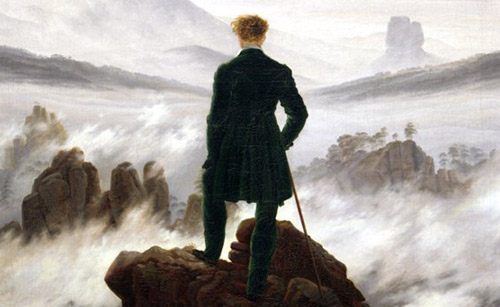|
查看原文
A number of recent books have lauded the connection between walking - just for its own sake - and thinking. But are people losing their love of the purposeless walk?
Walking is a luxury in the West. Very few people, particularly in cities, are obliged to do much of it at all. Cars, bicycles, buses, trams, and trains all beckon.
Instead, walking for any distance is usually a planned leisure activity. Or a health aid. Something to help people lose weight. Or keep their fitness. But there's something else people get from choosing to walk. A place to think.
Wordsworth was a walker. His work is inextricably bound upwith tramping in the Lake District. Drinking in the stark beauty. Getting lost in his thoughts.
Charles Dickens was a walker. He could easily rack up 20 miles, often at night. You can almost smell London's atmosphere in his prose. Virginia Woolf walked for inspiration. She walked out from her homeat Rodmell in the South Downs. She wandered through London's parks.
Henry David Thoreau, who was both author and naturalist, walked and walked and walked. But even he couldn't match the feat of someone like Constantin Brancusi, the sculptor who walked much of the way between his home village in Romania and Paris. Or indeed Patrick Leigh Fermor, whose walk from the Hook of Holland to Istanbul at the age of 18 inspired several volumes of travel writing. George Orwell, Thomas De Quincey, Nassim Nicholas Taleb, Friedrich Nietzsche, Bruce Chatwin, WG Sebald and Vladimir Nabokov are just some of the others who have written about it.
From recent decades, the environmentalist and writer John Francis has been one of the truly epic walkers. Francis was inspired by witnessing an oil tanker accident in San Francisco Bay to eschew motor vehicles for 22 years. Instead he walked. And thought. He was aided by a parallel pledge not to speak which lasted 17 years.
But you don't have to be an author to see the value of walking. A particular kind of walking. Not the distance between porch and corner shop. But a more aimless pursuit.
In the UK, May is National Walking Month. And a new book, A Philosophy of Walking by Prof Frederic Gros, is currently the object of much discussion. Only last week, a study from Stanford Universityshowed that even walking on a treadmill improved creative thinking.
Across the West, people are still choosing to walk. Nearly every journey in the UK involves a little walking, and nearly a quarter of all journeys are made entirely on foot, according to one survey. But the same study found that a mere 17% of trips were "just to walk". And that included dog-walking.
It is that "just to walk" category that is so beloved of creative thinkers.
"There is something about the pace of walking and the pace of thinking that goes together. Walking requires a certain amount of attention but it leaves great parts of the time open to thinking. I do believe once you get the blood flowing through the brain it does start working more creatively," says Geoff Nicholson, author of The Lost Art of Walking.
"Your senses are sharpened. As a writer, I also use it as a form of problem solving. I'm far more likely to find a solution by going for a walk than sitting at my desk and 'thinking'."
Nicholson lives in Los Angeles, a city that is notoriously car-focused. There are other cities around the world that can be positively baffling to the evening stroller. Take Kuala Lumpur, the Malaysian capital. Anyone planning to walk even between two close points should prepare to be patient. Pavements mysteriously end. Busy roads need to be traversed without the aid of crossings. The act of choosing to walk can provoke bafflement from the residents.
"A lot of places, if you walk you feel you are doing something self-consciously. Walking becomes a radical act," says Merlin Coverley, author of The Art of Wandering: The Writer as Walker.
But even in car-focused cities there are fruits for those who choose to ramble. "I do most of my walking in the city - in LA where things are spread out," says Nicholson. "There is a lot to look at. It's urban exploration. I'm always looking at strange alleyways and little corners."
Nicholson, a novelist, calls this "observational"walking. But his other category of walking is left completely blank. It is waiting to be filled with random inspiration.
Not everybody is prepared to wait. There are many people who regard walking from place to place as "dead time" that they resent losing, in a busy schedule where work and commuting takes them away from home, family and other pleasures. It is viewed as "an empty space that needs to be filled up", says Rebecca Solnit, author of Wanderlust: A History of Walking.
Many now walk and textat the same time. There's been an increase in injuries to pedestriansin the US attributed to this. One study suggested texting even changed the manner in which people walked.
It's not just texting. This is the era of the "smartphone map zombie"- people who only take occasional glances away from an electronic routefinder to avoid stepping in anything or being hit by a car.
"You see people who don't get from point A to point B without looking at their phones," says Solnit. "People used to get to know the lay of the land."
People should go out and walk free of distractions, says Nicholson. "I do think there is something about walking mindfully. To actually be there and be in the moment and concentrate on what you are doing."
And this means no music, no podcasts, no audiobooks. It might also mean going out alone.
CS Lewis thought that even talking could spoil the walk. "The only friend to walk with is one who so exactly shares your taste for each mood of the countryside that a glance, a halt, or at most a nudge, is enough to assure us that the pleasure is shared."
The way people in the West have started to look down on walking is detectable in the language. "When people say something is pedestrian they mean flat, limited in scope," says Solnit.
Boil down the books on walking and you're left with some key tips:
Walk further and with no fixed route
Stop texting and mapping
Don't soundtrack your walks
Go alone
Find walkable places
Walk mindfully
Then you may get the rewards. "Being out on your own, being free and anonymous, you discover the people around you," says Solnit.
|
查看译文
最近许多书都赞扬走路这一行为本身和思考的联系。但是人们是否正逐渐对漫无目的的行走失去兴趣?
走路在西方是件奢侈事。少有人会去步行,尤其是在城市里。汽车、自行车、公交车、电车和火车,这些都更吸引人。
走路反而通常是一种有计划的休闲活动,或者是保健运动,是有助于减肥或保持健康的活动。但是人们还可以从步行中得到其它一些东西,一种思考的环境。
华兹华斯(Wordsworth)喜欢步行。他的工作让他不可避免地要经常在湖区行走,在纯粹质朴的美景中饮酒,沉浸到思考之中。
查尔斯•狄更斯(Charles Dickens)也喜欢走路。他可以很轻松地走完20英里,而且经常是在夜里。从他的文章中你几乎可以嗅到伦敦的气息。弗吉尼亚•伍尔夫(Virginia Woolf)为寻求灵感而行走,她从家乡南唐斯的罗德麦尔出发,在伦敦的公园里漫步。
自然主义者、作家亨利•大卫•梭罗(Henry David Thoreau)则每天都在行走。但即使是他也无法做到康斯坦丁•布朗库西(Constantin Brancusi)那样的壮举。布朗库西是一位雕塑家,从罗马尼亚的农村老家到巴黎这一路,他几乎都是走着去的。更厉害的是帕特里克•莱斯•法莫(Patrick Leigh Fermor),他18岁时从荷兰角港徒步到伊斯坦布尔,旅程给了他灵感,让他写出了好几卷游记。乔治•奥威尔(George Orwell)、托马斯•德•昆西(Thomas De Quincey)、纳西姆•尼古拉斯•塔勒布(Nassim Nicholas Taleb)、弗里德里希•尼采(Friedrich Nietzsche)、布鲁斯•查特文(Bruce Chatwin)、 温弗里德•格奥尔格•泽巴尔德(WG Sebald)、弗拉基米尔•纳博科夫(Vladimir Nabokov)也都写过关于行走的文章。
近几十年来,环保主义者、作家约翰•弗朗西斯(John Francis)可谓真正的英雄般的行者。弗朗西斯在旧金山港目睹一场油罐事故,受此影响22年来一直决绝乘坐机动车辆。所以,他步行,同时思考。他还发誓不开口说话,坚持了17年。
不过,要发现行走的价值,不一定要成为作家。一种特殊的行走方式,不是从家门口走到街角的商店,而是一种漫无目的的行动。
在英国,五月是全国步行月。弗雷德里克•格罗(Frederic Gros)教授的一本新书《行走的哲学》(A Philosophy of Walking)目前广受关注。就在上周,斯坦福大学的一项研究显示即使是在跑步机上走一走也能促进创新思维。
在整个西方,人们仍会选择步行。一项调查表明,英国几乎每一趟旅程都会包含一点步行的路程,近四分之一的旅程是完全徒步的。不过,该调查还发现17%的旅程就是“走路”,还包括遛狗。
“单纯走路”这一类型深受创新思维者的喜爱。
“走路的速度和思考的节奏是相通的。走路需要一定的注意力,但是也给思考留下了很大的空间。我很相信一旦血液流经大脑,大脑就开始创造性地工作,”《消失的艺术:步行》(The Lost Art of Walking)的作者,杰夫•尼克尔森(Geoff Nicholson)说。
“你的感官变得敏锐。作为一名作家,我还把它当做一种解决问题的方式。出去走一走比只是坐在桌前‘冥思苦想’更有可能找到解决办法。”
尼克尔森住在洛杉矶,这个城市出了名的车多。世界上有许多城市会让走夜路的人很犯难,例如,马来西亚首都吉隆坡。在相距很近的两地走路也要很小心。人行道很神秘地就走到头了。穿过繁忙的街道也没有斑马线。选择步行会让当地居民非常不解。“在很多地方,如果步行,你会觉得自己在进行一项有意识的活动,步行成了一种激进的行为,”《漫步的艺术:行走的作家》(The Art of Wandering: The Writer as Walker)的作者梅林•科弗利(Merlin Coverley)说。
但是即使在车水马龙的城市,选择漫步也会有所收获。“我大多数都是在城市里,洛杉矶街头异彩纷呈,”尼克尔森说。“有很多可以看的。这是城市探险。我常常去看小巷和街角。”
尼克尔森是位小说家,他称这为“观察式”步行。不过其它种类的步行还空缺着,等待灵感降临时能补全。
但不是每个人都愿意等待。有许多人认为步行往返两地是“停滞的时间”,他们不愿从忙碌的日程安排里耽搁这点时间,在他们忙碌的日程里,工作和上下班让他们远离了家庭和其它乐趣。步行被看做是“需要填补的空白,”《浪游之歌:走路的历史》(Wanderlust: A History of Walking)的作者雷贝嘉•索尔尼(Rebecca Solnit)说。
现在许多人一边走路一边发短信。因为这个原因美国行人受伤率有所上升。一项研究显示发短信甚至会改变人们走路的方式。
不仅仅是发短信。这是“智能手机地图僵尸”的时代——人们偶尔从电子导航上抬头看一眼,以防踩到什么东西或被车撞。
“不看手机人们就没法从一个地方到另一个地方,”索尔尼说。“过去人们都会去主动了解一个地方。”
人们应该出去,不受干扰地行走,尼克尔森说。“我真的认为有用心行走这回事。此时此地,专注于你正做的事。”
这意味着没有音乐,没有播客,没有有声读物。或许还指独自行走。
克利夫•斯特普尔斯•刘易斯(CS Lewis)认为即使是说话也会破坏行走的过程。“走路时唯一的朋友是能够完全分享你在乡间行走时的每一个心境的体验的人,一个眼神、一个停顿、或者至多轻碰一下就足够确定我们同享这一乐趣。”
在西方,人们对走路的轻视在语言中也有迹可循。“人们说某样东西‘pedestrian’,就是说它平淡无奇、很一般,”索尔尼说。
总结这些关于行走的书,可得出一些要点:
走远一点,不要局限于一条路线
不要再发短信、看导航了
不要边走边听有声读物
独自出发
走可走的路
用心行走
那么你会得到回报。“独自出发,自由自在、漫无目的地行走吧,去了解你周围的人,”索尔尼说。
(译者 巴黎的思不灵 编辑 丹妮)
扫一扫,关注微博微信
 
|

